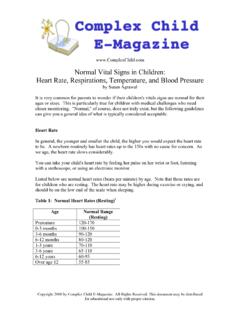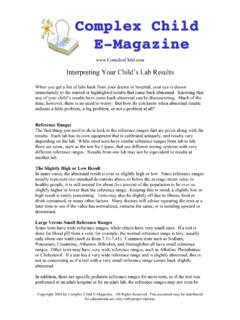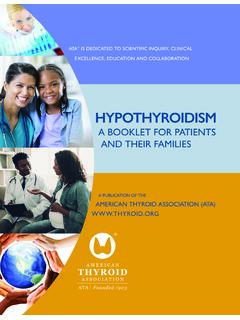Transcription of Fluid Requirements for Children - Complex Child
1 Copyright 2008 by Complex Child E-Magazine. All Rights Reserved. This document may be distributed for educational use only with proper citation. Fluid Requirements for Children by Susan Agrawal As the summer months approach and temperatures rise, dehydration becomes a concern for Children , particularly those who have feeding problems or other medical issues. Keeping your Child hydrated is one of the simplest ways to maintain health and prevent medical problems. But how do you know how much Fluid your Child needs, especially if your Child does not drink fluids orally or has difficulty associating thirst with drinking? The easiest way to make sure your Child is hydrated is to keep track of how much urine she is producing, with babies having at minimum 4-8 wet diapers a day, and older Children urinating at least 4-8 times a day. If you are concerned about your Child s Fluid intake, you may want to calculate how much liquid he should be receiving based on his size.
2 The simplest method for determining Fluid needs is the Holliday-Segar Calculation. This method bases Fluid Requirements on the Child s weight, using the average requirement of 100 mL water for each 100 calories metabolized. While this calculation is widely used, it has been called into question recently. First and foremost, the Fluid Requirements in this calculation were determined based on intravenous administration and not oral or enteral intake. They are also not valid for newborns, Children who are overweight, or older Children nearing full adult size. Table 1 summarizes Fluid Requirements using this method. For the first 10 kg of weight, a Child needs 100 mL per kg of weight. For the next 10 kg of weight (11-20 kg), a Child only needs 50 mL per kg of weight. And for anything over 20 kg (21 kg of weight and higher), the Child only needs 20 mL per kg of weight. Take a 35 kg Child , for example. He needs 1000 mL for his first 10 kg of weight (10 kg x 100 mL), 500 mL for his second 10 kg of weight (10 kg x 50 mL), and 200 mL for any weight above 20 kg (15 kg x 20 mL).
3 A 35 kg Child , therefore, needs approximately 1800mL of water or free liquids. Children who are vomiting, have diarrhea, are sweating excessively, or who are exposed to extremely high temperatures, require even more fluids than listed above. Moreover, Children with medical problems that cause them to metabolize calories at a slower or faster rate made need more or less fluids. For example, a Child who is inactive due to cerebral palsy may require less fluids, while a Child who has diabetes may require more fluids. It is important to talk to your Child s doctor or dietician about your Child s particular Fluid needs, based on her age, size, activity level, and medical history. 2 Tabel 1: Fluid Requirements based on Holliday-Segar Method Holliday-Segar Method for Calculating Fluid Requirements Body Weight of Child Water/Free Liquids Required 5 kg (11 lbs) 500 mL ( oz) 6 kg ( lbs) 600 mL (20 oz) 7 kg ( lbs) 700 mL ( oz) 8 kg ( lbs) 800 mL ( oz) 9 kg ( lbs) 900 mL (30 oz) 10 kg (22 lbs) 1000 mL ( oz) 11 kg ( lbs) 1050 mL (35 oz) 12 kg ( lbs) 1100 mL ( oz) 13 kg ( lbs) 1150 mL ( oz) 14 kg ( lbs) 1200 mL (40 oz) 15 kg (33 lbs) 1250 mL ( oz) 16 kg ( lbs) 1300 mL ( oz) 17 kg ( lbs) 1350 mL (45 oz) 18 kg ( lbs) 1400 mL ( oz) 19 kg ( lbs) 1450 mL ( oz) 20 kg (44 lbs) 1500 mL (50 oz) More than 20 kg (>44 lbs) 1500 mL + 20 mL per kg over 20 kg 25 kg (55 lbs) 1600 mL ( oz) 30 kg (66 lbs) 1700 mL ( oz) 35 kg (77 lbs) 1800 mL (60 oz) 40 kg (88 lbs) 1900 mL ( oz) Conversion Chart 1 kg = lbs 30 mL = 1 oz What counts as a Fluid ?
4 For young babies, formula or breastmilk is usually adequate since infant formulas and breastmilk (with 20 calories per ounce) are typically 95% free water. Water and juice can be introduced around six months of age. Children over a year of age who eat regular diets can get their fluids from a variety of sources. Water is of course the best option, but clear liquids such as juice, gatorade, and even popsicles are a good second choice. Milk, fresh fruits and vegetables, and other wet foods also will provide ample fluids to the body. As long as your Child is eating a wide variety of foods and drinking the appropriate amount of water, milk, and juice, she should stay well-hydrated. Children on special diets or who are tube fed require more careful monitoring of Fluid intake. Many of these Children suffer from chronic low-level dehydration, which can contribute to worsening reflux, constipation , stomach discomfort, and even irritability or 3 pain. Pediatric formulas (30 calories per ounce) are typically 85% free water, and can serve as the main source of fluids for most Children .
5 It is important, however, that Children who are formula-fed still receive some free water. Free water is extremely helpful to combat many gastrointestinal ailments, ranging from reflux to constipation and other motility issues. Free water should be offered to Children frequently throughout the day, especially if the Child does not sense or indicate thirst well. Children who are tube fed should receive water flushes throughout the day, and water boluses several times a day if tolerated. Another option, particularly for Children weaning off feeding tubes, is to give water overnight while the Child is sleeping. Feeding therapist Suzanne Evans Morris has written extensively on the importance of water for Children with gastrointestinal problems, and her opinions and recommendations can be found here: It is important to be able to recognize the signs of dehydration in a Child . Mild dehydration often is asymptomatic, with thirst and yellow urine the only signs. More serious dehydration leads to dryness in the skin, lips, and tongue, irritability, and decreased urine output.
6 Severe dehydration, which requires immediate medical attention, causes lethargy, clammy skin, a parched mouth, and a fast and weak pulse. See Table 2 below for a complete description of these Table 2: Signs of Dehydration Signs of Dehydration sign Mild Dehydration Moderate Dehydration Severe Dehydration skin normal dry clammy lips/tongue moist dry parched eyes normal deep set sunken tears present reduced none fontanelle flat soft sunken mood consolable irritable lethargic pulse normal increased rate, weak increased rate, feeble urine output normal, yellow decreased, dark yellow no urine It is definitely possible to drink too much water. Overloading the body with fluids can cause water intoxication or hyponatremia, an imbalance between water and sodium in the blood plasma. Fortunately, this is a very uncommon occurrence in Children . While you and your Children enjoy the summer heat, make sure that you all stay well hydrated! iAdapted from Brian Stone, Fluids and Electrolytes, in The Harriet Lane Handbook, 17th Edition, edited by Jason Robertson and Nicole Shilkofski.
7 Philadelphia: Elsevier Mosby, 2005, p. 298.





